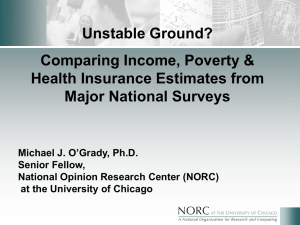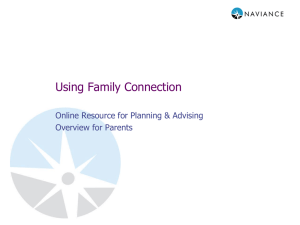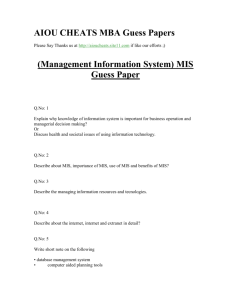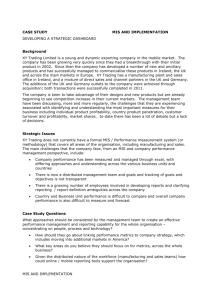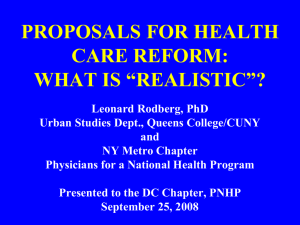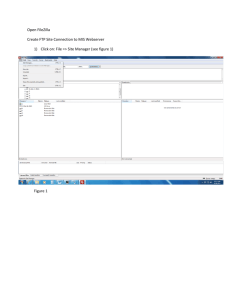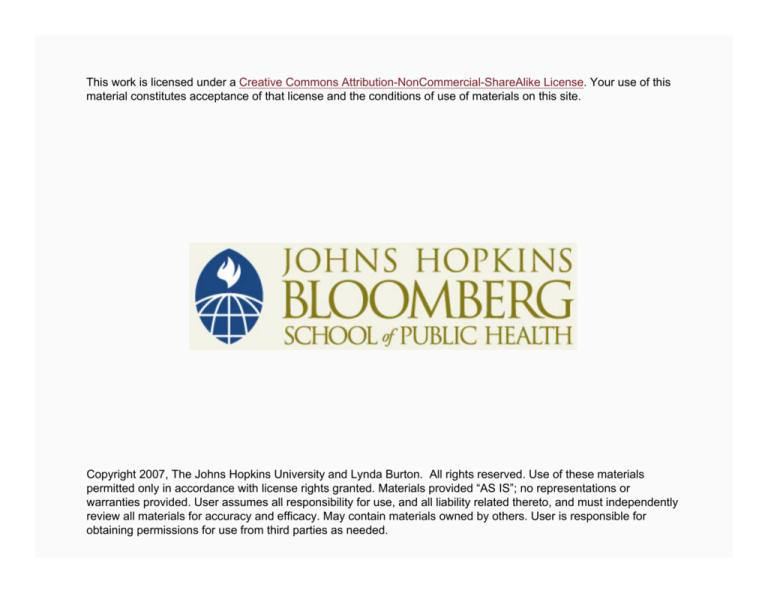
This work is licensed under a Creative Commons Attribution-NonCommercial-ShareAlike License. Your use of this
material constitutes acceptance of that license and the conditions of use of materials on this site.
Copyright 2007, The Johns Hopkins University and Lynda Burton. All rights reserved. Use of these materials
permitted only in accordance with license rights granted. Materials provided “AS IS”; no representations or
warranties provided. User assumes all responsibility for use, and all liability related thereto, and must independently
review all materials for accuracy and efficacy. May contain materials owned by others. User is responsible for
obtaining permissions for use from third parties as needed.
Application of Information Systems and Secondary
Data
Lynda Burton, ScD
Johns Hopkins University
Section A
Secondary Data
Application of Secondary Data Sources to HSRE
Pre-existing or pre-collected data is considered “secondary”
as opposed to data collected specifically for a project which is
considered “primary”
There are a wide variety of secondary data sources
4
Secondary Data for HSRE: Several Major Categories
Archival data or record systems
Ongoing “monitoring” systems/special repetitive “surveys”
Management information systems (MIS)
Billing transaction systems or other limited MIS
Special “one-shot” databases developed by other researchers
5
Advantages of Secondary Data
Cheaper
Available quickly
Usually available for long time periods, therefore useful in
time series analyses
Many are quite reliable and valid
Often can be used to target primary data collection
6
Disadvantages of Secondary Data
Available data are rarely perfect for your research needs
Reliability and validity problems may be present
Risk of breach of confidentiality exists
7
Archival Data Systems and Record Systems
Major goal is to provide an archival historical documentation
of health-related occurrences or activities
Responsibilities of those collecting the data usually stop after
the database has been developed
These systems often have legal implications or satisfy some
reporting requirements
Many problems exist with regard to uniformity
8
Examples of Archival Data Systems
Vital records (birth, death)
HSCRC hospital discharge files
State-mandated “incident” reports
Medical records
9
Use of Medical Records in Research
Patient/client treatment records are the most ubiquitous data
system in health care organizations
Provides the most detailed account of treatment process and
patient clinical and demographic characteristics
10
Disadvantages of Use of Medical Records in Research
Record quality is inconsistent
Often impossible to read
Information not uniformly reported
Difficult to retrieve compared to automated records
11
Management Information Systems
Definition
A systematic method used to collect, process, store, retrieve,
and transmit selected data on patients/clients, clinical
activities, and financial transactions that provides some
organizational personnel with information required to carry
out a specific management function
12
Management Information Systems
Usually conceived with a specific organization or program
− Hence, mostly applicable to HSE
There are as many non-functional MIS’s as there are
functional ones
An MIS is not necessarily automated
Unless information is used consistently, validity and reliability
issues almost always exist
MIS data are usually timely (often “real time”)
If evaluation is objective from beginning, HSE can
theoretically be fully integrated into MIS
13
Examples of MIS
Total hospital information system
Encounter reporting system
Hospital financial reporting systems
Some medical record systems
− Nursing home minimum data set
14
Billing/Transaction Data Systems
Limited for the most part to financial data (very little clinically
significant data)
Often only data available in machine-readable form on
majority of health care transactions
Can be used for large scale analyses
Fairly reliable, both payor and payee are interested in
accurate data
Often difficult to gain access
15
Examples of Billing Data Systems
Blue Cross records
Medicare files
− National Claims History files
− 5% files
Medicaid files
Hospital billing systems
16
Section B
National Surveys of Importance to HSR
Features of National Surveys
Sample drawn to be representative of large group (usually
national population)
Questions validated
Data collection methods highly reliable
Often panel survey, though some cohort surveys
With panel surveys, replacements added
18
Secondary Data Sources for HSRE: On-Going National
Surveys
National Health Interview Survey
National Hospital Discharge Survey
National Ambulatory Medical Care Survey
NHANES
Medical Expenditure Panel Survey
Medicare Current Beneficiary Survey
19
National Health Interview Survey
Principal source of information on health for U.S. population
Continuing survey with special studies added
Household interviews
Non-institutionalized, civilian population
Probability sample representative of the target population
20
National Health Interview Survey: Purpose
Provide national data on . . .
− Incidence of acute illness and accidental injuries
− Prevalence of chronic conditions and impairments
− Extent of disability
− Utilization of health care services
− Other health-related topics
21
Office Visits Per Year By Patient’s Age
Office Visits Per Year
7
Male
Female
6
5
4
3
2
1
0
All
<15
15-24
25-44
45-64
65-74
75+
Patient's Age
Notes Available
22
Percentage of Adults Who Were Overweight* by Selected
Characteristics: U.S., 1997 –1998
*Overweight = BMI of 25 or more
Selected
Characteristic
Age
18-24 years
25-44
45-64
65-74
75 years and over
Percent of adults (standard error)
Both
Sexes
Male
Female
37.5 (0.72)
53.7(0.36)
63.5(0.43)
61.1(0.67)
47.2(0.75)
42.5 (1.06)
64.3(0.48)
71.5(0.61)
67.0(0.93)
50.0(1.31)
32.3(0.95)
43.2(0.47)
43.2(0.47)
56.2(0.91)
45.3(0.88)
60.4(0.52)
56.8(0.44)
47.5(0.60)
42.4(0.99)
62.0(0.75)
64.7(0.65)
59.0(0.89)
53.7(1.73)
58.7(0.75)
49.7(0.55)
35.7(0.85)
29.2(0.96)
56.9(0.66)
58.7(0.60)
56.7(0.43)
57.0(1.10)
62.4(0.84)
63.5(0.65)
56.6(0.83)
55.4(0.78)
49.7(0.58)
Education
Less than high school graduate .....…
High school graduate ...………
Bachelor of Arts,Science degree .....…
Master ’s,doctorate,medical degree .....
Poverty status
Below poverty level ..........................
1.00 –1.99 times poverty level ..................
2.00 –3.99 times poverty level ...................
Notes Available
23
Family Income by Age
40
All Ages
Under 65
35
Percent
30
25
20
15
10
5
0
< $5,000
$5000$9,999
$10,000$19,999
$20,000$34,999
$35,000$49,999
>$50,000
Family Income
Notes Available
24
National Hospital Discharge Survey
Data abstracted from medical records of discharges from
short-stay, non-federal hospitals
Coded using ICD9-CM categories
Number, rate, and average length of stay, by age, geographic
region, and gender
Number of discharges by first listed DX
25
Number of Discharges from Short-Stay Hospitals by
Selected Characteristics (United States, 2000)
Selected
Characteristic
Both
Sexes
Male
Female
Number In Thousands
Total..........................................................
31,706
12,514
19,192
Age
Under 15 Years.........................................
15-44 Years...............................................
45-64 Years...............................................
65 Years and Over....................................
2,383
9,969
6,958
12,396
1,333
2,680
3,424
5,077
1,050
7,289
3,534
7,319
Region
Northeast...................................................
Midwest.....................................................
South.........................................................
West..........................................................
7,103
7,207
12,016
5,380
2,979
2,857
4,621
2,057
4,123
4,351
7,395
3,323
Notes Available
26
Rate of Discharges from Short-Stay Hospitals by Selected
Characteristics (United States, 2000)
Selected
Characteristic
Both
Sexes
Male
Female
Number Per 1,000 Population
Total..........................................................
114.0
92.0
135.1
Age
Under 15 Years.........................................
15-44 Years...............................................
45-64 Years...............................................
65 Years and Over....................................
39.4
81.6
114.2
359.6
43.1
43.9
115.8
352.8
35.5
119.3
112.6
364.4
Region
Northeast...................................................
Midwest.....................................................
South.........................................................
West..........................................................
135.5
112.8
121.6
85.4
117.4
91.5
96.4
65.4
152.5
133.2
145.4
105.3
Notes Available
27
National Ambulatory Medical Care Survey
Describes ambulatory care visits made to physician offices
within the U.S.
− By physician practice characteristics
− By patient age, gender, race
− By payment type and expected source of insurance for
this visit
− By patient’s principal reason for visit
28
Percentage Distribution of Office Visits: U.S., 2000
Physician Practice
Characteristic
All visits
General and family practice .....................
Internal medicine ............................
Pediatrics ................................
OB/GYN….
Orthopedic surgery….
Number of Visits
in thousand
Percent
Distribution
823,542
100
198,578
125,556
103,734
65,135
46,155
24.1
15.2
12.6
7.9
5.6
756,813
66,729
91.9
8.1
183,029
206,727
251,300
182,485
22.2
25.1
30.5
22.2
Professional Identity
Doctor of Medicine
Doctor of Osteopathy
Geographic Region
Northeast
Midwest
South
West
Notes Available
29
National Health and Nutrition Examination Survey
(NHANES)
Population-based
Designed to assess the health and nutritional status of adults
and children in the U.S. through interviews and direct
physical examinations
Medical and dental examinations, physiological
measurements, laboratory tests
30
Medical Expenditure Panel Survey (MEPS)
Provides policy makers with up-to-date, highly detailed
information on how Americans as a whole and different
segments of the population use and pay for health care
Documents insurance coverage and other access issues
31
Example of Findings: MEPS, 2001
In the first half of 1999, 15.8% of all Americans were
uninsured
Among Americans under 65, 36% of Hispanics and 21% of
blacks were uninsured during the first half of 1999, compared
with only 14% of whites
Even though Hispanics represented only 13% of the nonelderly U.S. population, they accounted for a fourth (25%) of
the entire uninsured population
32
Example of Findings: MEPS, 2001
Young adults ages 19–24 were more at risk of being
uninsured than any other age group (almost a third (32%) of
young adults were uninsured)
During the first half of 1999, among people under age 65,
those who were separated from their spouse were more likely
to be uninsured (33%) than people of any other marital status
33
Medicare Current Beneficiary Survey
Interviews with about 10,000 Medicare beneficiaries
Nationally representative sample
Data collected include:
− Self-reported health and functional status
− Access to care
− Satisfaction with care
Survey data can be linked to claims data
34

